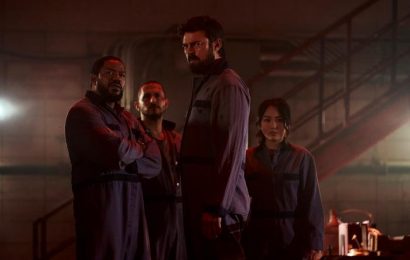When Angela Bassett and costume designer Ruth Carter collaborate, the conversation between actor and artisan does not revolve around dress color or texture. Carter says it’s a discussion about the intention of a scene, and how best to portray that character.
The two have worked on five projects, including “Malcolm X,” “What’s Love Got to Do With It?” and the “Black Panther” films.
Over the years, they have had moments where their voices have been squashed. But that has changed. Says Carter, “Because of our strides as creatives, as women, as actresses, we have proven that things have changed.” Adds Bassett, “We stood the test of time.”
Here, they discuss their Creative Collaboration, finding their voices, and how they are proof of change.
Let’s go back to the first time you collaborated, back in 1992 on Spike Lee’s “Malcolm X.” What do you remember?
Ruth Carter: I met the real-life Betty Shabazz (Bassett’s character) when she was teaching in New York. We sat together in a classroom, and she told me her mother didn’t want her to become a Muslim. When she became one, she was very concerned about her image. Her mother would send her clothes and wanted her to have a certain image – how she dressed, and how she looked. When I first approached Angela with costume design, most of the things that I had prepared for her were based on that conversation about being respectable and honorable with the way that you dress. We wore things that I remember when sitting in church and being able to match the earrings to the textures and colors of the clothes. I wanted to bring in a bit of religion and culture, together with this Muslim woman.
Angela Bassett: I didn’t have the opportunity to spend time with her. But for me, it was the first time I played a real person. I was of the idea that you think of history, as it was or history as it is remembered and recalled, or revised to be. My thought was to speak with her eldest daughter, Attallah, to hear her talk about her mother and this idea of who her mother was. I do remember one incident where Dr. Shabazz was saying she never wore cotton pajamas. Her sleeping attire was silk. Again, in that same vein, how you presented yourself was very important.
Carter: I think what people remember about themselves is much more than when you look at their socio-economic status and how they were struggling. I felt the same thing happened when we met Tina Turner. She said, “I always wore Armani.” I thought, “In Nutbush? Okay.”
The next film you worked on after that was “What’s Love Got to Do with It?” where you play another real person — this time, Tina Turner. How had your relationship evolved between the two films? Angela, what was it like for you working with a costume designer that you had worked with before and how did that help?
Bassett: Working on “Malcolm” was such a unique experience. There was all this chatter that another director was to direct it, and Spike became the director. He had to hold it together to get the funds, and how the community came in and saved that movie. He was able to make the film that he wanted to. There was so much brotherly and sisterly respect on that set and so much love. You only heard beautiful language and expressions of love and appreciation. It was something special. We knew we were climbing a mountain and fighting lions, and we made it across that finish line. It’s something to be proud of.
Ruth and I had the opportunity to work together again; you feel like we have been through something. We are sisters in the name of love. As artists, we’re trying to tell our stories about one of our leaders, so here we are. And now we’re going to tell it about her, and the struggle that she went through, so there was this beautiful familiarity.
Carter: You don’t work with someone like Angela Bassett and not learn from her. She is a consummate actress. You see that in action when she’s preparing. She’s not shy about where she prepares. She sits on the side of the set preparing. Every time I have come together with Angela Bassett, I have learned something about her and about how she works and how she delivers. On “Malcolm X” I saw her go toe to toe with Denzel. I was behind the camera, and Denzel Washington is in the room. We love him, but Angela Bassett is in the room, too. There was this scene where they were having a debate about the Nation of Islam. Angela did not let him into it at all. They have this [verbal] volleyball and debate. When Spike said, “Cut,” all Denzel could say was, “That was good.” As a bystander and designer, I’ll never forget that. I want to support that performance.
We’re constantly collaborating. Whether we’re doing it eye-to-eye, or observing each other’s process, it gives me more of an understanding of Angela Bassett. We’re not collaborating on, “What color do you think this dress should be?” We’re saying, “What’s the intention of the scene and how do we portray this character and person?” During “What’s Love Got to Do With It?” Tina Turner came to set one day, and it was pretty crazy and unexpected. The first day she was there, everyone said, “Ruth, show her your book.” I think she said something like, “I would never wear that,” and I knew she was going to say something like that. We ended up collaborating, and it culminated when I saw her braiding Angela’s hair. Angela was sitting on the floor, and Tina was sitting above her. There was no Instagram or iPhones, and I saw a woman passing her crown. That was a gift to me, to be able to be in the room, and that’s what I carried into the next film and the next.
Bassett: That was the last day. She did my makeup in 10 minutes. That was an interesting ride. We would show up every day. You had done your thing and there were over 50 costumes. But it was crazy. We’d have eight hours off, maybe 10. We were trying to get this movie out to coincide with her world tour and to see her life story. This was going to happen in three months. We’d come to the set and we would be on location, and you would have limited space in your trailer.
Carter: I didn’t know back then. I should have asked for a bigger space.
Bassett: But back then, it got to a point where before leaving the set we would try on costumes for the next day, do a little show and get the check approval from the director. We’d go home for seven hours, listen to those songs and come back to set the next day.
Carter: We were co-llab-or-at-ing. Some days we had to just bow our heads in prayer because it was intense.
Bassett: We tried to take pictures and do a live show, but every day, we had to keep our wits about us.
Carter: I’d be in that trailer. Like that jumpsuit — the black lace one-piece. That was planned for Vanessa Bell Calloway, but now it was Angela’s. That was in the early days of Black women and Hollywood and not having the trust and voice that we deserve. We’re going through the same motions as anyone else, and yet, we’re still denied, we’re still questioned. I looked at it then, as a young designer and it was part of the creative process. I came through Spike Lee, who was our fearless leader and hero, so, I walked into Hollywood the same way asking, “What do I need to do?”
Bassett: I think you’re absolutely right. From my experience, when I tried that, it was no, no, no. But when Laurence [Fishburne] tried it, it was a yes. I immediately saw that a male thing and I would just have to do it and move on. If I wanted to talk about it or ask about a take and I asked, “Well, I would like what if I tried that?”, the response was, “No.” It was a male thing, and I would just have to do it. “You’re the lowly actor” or whatever. I would literally have to bring up Phyllis Yvonne Stickney, who played my sister, into the scene, she would get a close-up that way. It was interesting. I remember thinking, “It’s a war, you’re going to have to get to the end and it’s going to be fine.” Once I saw the first dailies, I could have confidence that what we were doing resonated and had power. It was authentic and believable and it looked good. So, the day-to-day grind of what we went through, and trying to have a voice as an actor was squashed. I thought, “OK, I won’t do that. I’ll just do it in the scene.”
Carter: I remember on “How Stella Got Her Groove Back,” I showed the director this pink tracksuit you were going to wear while on the beach, and he said, “Pink!? How could you wear pink? Why would you wear pink?” I was like, “Look, I’m in Jamaica. Can it just be pink?” Now, when I see that scene and that wide shot, I think it’s the perfect color. Courtney [B. Vance, Bassett’s husband] came to the set and said to the director, “Let a girl wear pink.”
To your point, that was 1998. How has the industry changed with your voices? What was your experience on “Black Panther: Wakanda Forever” and working with Ryan Coogler?
Bassett: They seek out your voice, experience, view and perspective. They surround themselves with you. They want you because —
Carter: — now you have a body of work that they can rely on. They know, speaking about Angela, she has a reputation she can deliver. They know exactly what they’re going to get in the scene and who’s showing up. I think because of our strides as women, as actresses, as creatives, we have proven that things have changed. There are characters that we can portray that are multi-dimensional, layered and beautiful at the same time. They want that. I think there are a lot of things about this whole zeitgeist that has shifted that includes us.
Bassett: We stood the test of time. We were born to do this, gifted to do this. We’ve trained to do this. We respect doing this. We bring all of that professionalism and excellence to work every day, and we share it with everyone around us…and I’m speaking about Ruth. We remain relevant and excited and in wonder about what we do. We have an Oscar. We are executive producers and some look to us for inspiration, and we’re still trying to grow and challenge ourselves.
Carter: I love when I hear Ryan Coogler say, “I grew up watching Angela Bassett’s films, and I grew up watching Ruth Carter’s films.” I love when I hear a young man acknowledge the women and the growth and everything that we’d done.
Read More About:
Source: Read Full Article







